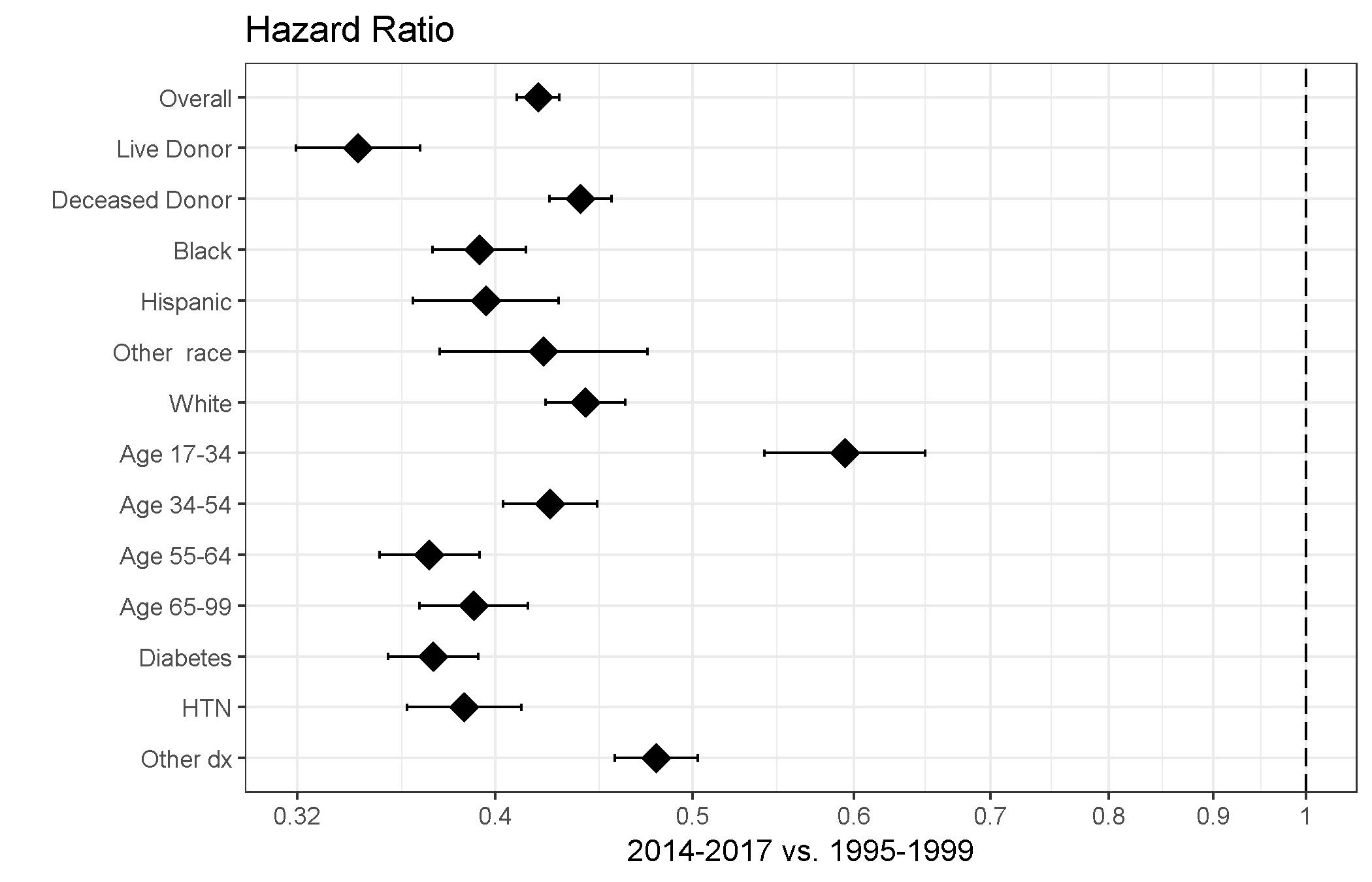Improvement in Long Term Kidney Transplant Survival Most Dramatic among Minorities, Diabetics and Older Patients
1Nephrology, Cleveland Clinic, Cleveland, OH, 2Quantitative Health Sciences, Cleveland Clinic, Cleveland, OH, 3Urology, Cleveland Clinic, Cleveland, OH, 4Nephrology, Johns Hopkins, Baltimore, MD
Meeting: 2020 American Transplant Congress
Abstract number: 265
Keywords: African-American, Graft survival, Kidney transplantation, Outcome
Session Information
Session Name: All Organs: Disparities to Outcome and Access to Healthcare I
Session Type: Oral Abstract Session
Date: Saturday, May 30, 2020
Session Time: 3:15pm-4:45pm
 Presentation Time: 3:27pm-3:39pm
Presentation Time: 3:27pm-3:39pm
Location: Virtual
*Purpose: Short-term and long-term kidney transplant graft survival has been improving over time, but whether this improvement in outcomes is more pronounced in the early (1 year) compared to later periods, and whether it is different among certain patient populations is unknown.
*Methods: We examined the SRTR for all deceased and living adult kidney transplants b/w Jan 1, ’95 and Dec 31, ’17. The cohort was grouped by eras spanning 4-5 yrs, and then analyzed by type of transplant, race, age groups and diagnoses. We calculated the unadjusted relative percent change in graft survival improvement at 1- and 5-years, and the HR by adjusted Cox proportional models for patients transplanted during era ’95-’99 compared to patients transplanted in era ’14-’17.
*Results: 331,214 kidney transplants were included, with 63.6% recipients of deceased donors (n=210,664) and 36.4% living donors (n=120,550). Age was 49.4 (13.7) yo and 39.7% were female. On average, one-year graft survival has improved by 6.2% from ’95-’99 to ’14-’17 (Figure 1), but this improvement was significantly more pronounced for longer term survival (12.7% for 5-year graft survival in ’10-’13 vs ’95-’99). Overall transplant survival has improved dramatically (HR=0.42, 95% CI: 0.41, 0.43 for ’14-17’ vs. ’95-99’). The most pronounced improvement was seen in recipients of living kidney donors (0.34, 95% CI: 0.32, 0.37), AA (0.39, 95% CI: 0.37, 0.41) and Hispanic races (0.40, 95% CI: 0.36, 0.43), older patients (0.39, 95% CI: 0.37, 0.42) and recipients with a diagnosis of DM (0.37, 95% CI: 0.35, 0.39) or HTN (0.39, 95% CI: 0.36, 0.41) (Figure 2).
*Conclusions: Kidney transplant survival has significantly improved since ’95 to date. While 1 year graft survival has increased, the more pronounced improvement is evident in 5 year graft survival. Importantly, while the long-term outcomes of all kidney transplant recipients are improving over time, minorities, older patients, those with higher comorbidities and recipients of living donors have improved the most.
To cite this abstract in AMA style:
Poggio ED, Arrigain S, Wee A, Brennan DC, Schold JD. Improvement in Long Term Kidney Transplant Survival Most Dramatic among Minorities, Diabetics and Older Patients [abstract]. Am J Transplant. 2020; 20 (suppl 3). https://atcmeetingabstracts.com/abstract/improvement-in-long-term-kidney-transplant-survival-most-dramatic-among-minorities-diabetics-and-older-patients/. Accessed January 4, 2026.« Back to 2020 American Transplant Congress


